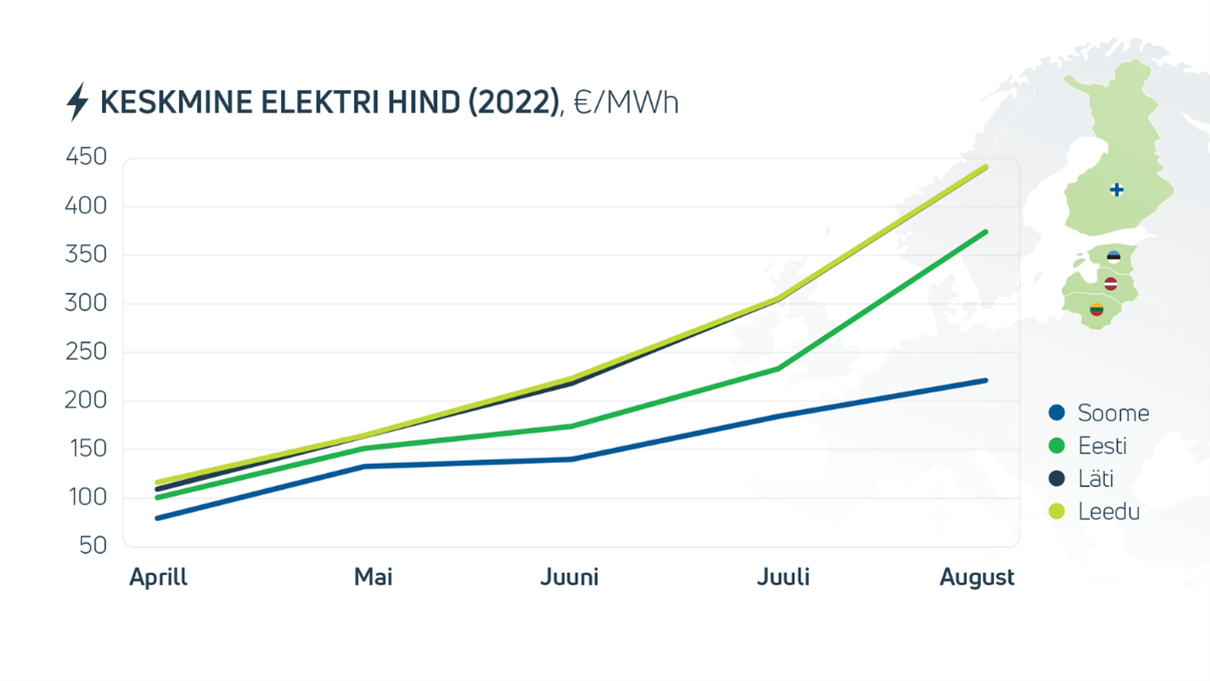The average exchange price of electricity last week in the Estonian price area was 422,61 eur/MWh, being 19,47% higher than the week before.
| Price area | Average exchange price | Change (previous week) |
| Estonia | 422,61 eur/MWh | +19,47% |
| Latvia | 512,48 eur/MWh | +21,72% |
| Lithuania | 514,67 eur/MWh | +22,24% |
| Finland | 260,55 eur/MWh | +87,08% |
On 17 August between 6 and 7 o’clock in the evening, the exchange price of electricity in the price area of Estonia, Latvia and Lithuania was 4,000 EUR/MWh. 4,000 euros is the maximum price on the power exchange, which occurs automatically if there is not enough production to cover consumption.
At that hour, the demand for electricity in the Baltics was about 2,992 megawatt-hours. 1,100 megawatt-hours of electricity were produced in these countries at that point and the rest was imported. There was a shortfall of 2.14 megawatt-hours of electricity to cover the demand. The competition authorities of Estonia, Latvia and Lithuania will jointly investigate the reasons behind the anomalous hour.
Explanations of the market participants and Nord Pool revealed that Lithuanian energy companies did bid on the power exchange, but they were not accepted. These were block tenders, for which the condition applies that the plant can enter the market only if the price in the block tender is lower than the average market price of the hours offered in the tender. If the average price of the hours offered in the tender on the market is not high enough, then unfortunately that block tender cannot be placed on the market. The total capacity of gas plants in Lithuania is 2,000 MW. Although the total capacity of Enefit Power’s power plants and Enefit Green’s wind farms is approximately 1,600 megawatts, the actual capacity offered to the market was affected by scheduled summer maintenance of plants and low winds in our region.
The cheapest exchange price of the week was in the early morning of 21 August when the price of electricity was close to zero for four hours. The exchange price of electricity has risen consistently since April: nearly 3.7-fold in Estonia, more than four-fold in Latvia and Lithuania.

The price of natural gas also continued to increase, reaching 261 EUR/MWh on Friday, surpassing the previous record set at the beginning of March. The price per megawatt hour of natural gas is ten times more expensive than it was last August. Russia’s export cuts continue to affect the price level. Gazprom will stop flows in Nord Stream 1 from 31 August to 2 September due to maintenance. In addition, natural gas is being stockpiled as much as possible for the coming winter in Europe. EU has set a goal of filling gas reserves to at least 80% by the first of November. The current average level of gas reserves in the European Union is 77%.
In the European emissions trading system, the CO2 quota price reached a record level of 98 EUR/t last week, because auction volumes have decreased in August. Yet at the beginning of August, a ton of CO2 cost 76 euros. The CO2 emission quota has a significant impact on the prices of fossil fuel power plants and thus on the price level of the universal service that will be revealed in the near future.
Last week, Unit 11 of Balti Power Plant as well as Units 4, 5 and 6 of Eesti Power Plant underwent their planned and long-announced summer maintenance. In addition, Auvere Power Plant was under maintenance, re-entering the market on 20 August. Scheduled maintenance continues this week in Unit 5 of Eesti Power Plant, while scheduled maintenance of Unit 3 will begin at the end of the week.
Several planned maintenance of power plants will continue in the region in the coming weeks in order to increase their reliability for the autumn-winter period. Unit 2 of Loviisa Nuclear Power Plant in Finland with a capacity of 507 MW is under scheduled maintenance until 9 September. Finland’s new Olkiluoto Unit 3 is currently shut down and will be restarted on 23 August. Unit 4 of Ringhals Nuclear Power Plant in Sweden is under scheduled maintenance until 7 September.
The price of electricity is formed on the power exchange for each hour depending on the production capacity and consumer demand for that particular hour.
The market overview has been prepared by Eesti Energia according to the best current knowledge. The information provided is based on public data. The market overview is presented as informative material and not as a promise, proposal or official forecast by Eesti Energia. Due to rapid changes in electricity market regulation, the market overview or the information contained therein is not final and may not correspond to future situations. Eesti Energia shall not be responsible for any costs or damages that may arise in connection with the use of the information provided.



